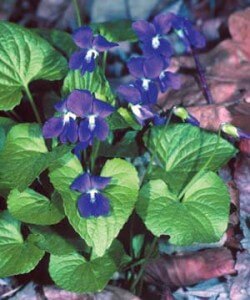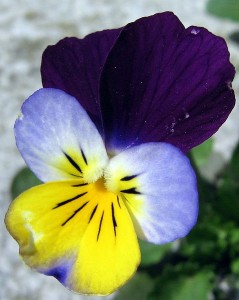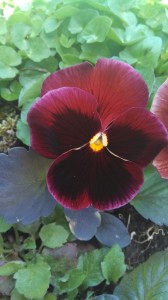Wild Violets

Johnny jump ups, hearts ease, pansies, wild violets, and a host of other names all point to plants in the Viola genus. There are 400-500 species worldwide and they can be found in almost all temperate climates. In the North Eastern United States Viola sororia is a common wild violet. This information also applies to most other species of violets and certainly the common pansy that can be purchased in early spring at any garden center.
Edibility and Culinary Use
The whole wild violet plant is edible. Leaves and flowers can be eaten raw or cooked, raw leaves are nice and crunchy with a slightly mucilaginous texture. The flavor of wild violets is mild, not overwhelming so you can eat a whole bunch at one time. They are commonly used as a lettuce substitute in salads and sandwiches. The roots are one of my favorite spring snacks, right when the leaves start coming up in early spring, you can uproot the entire plant and find small edible tubers on some species, such as Viola sororia. Wash the tubers then lightly boil or steam these to soften them up a bit before they are served.
Health Benefits
Historically wild violet leaves and flowers have been used for a number of ailments from headaches to asthma, to sore throats, even whooping cough, just to name a few. It has also been used as a breath freshener. The plant is valued for its anti-fungal, anti-inflammatory, and antiseptic properties. Wild Violets and Pansies also contain salicylic acid, which is a pain reliever.

Identification
Wild violets are difficult to identify when flowers are not present. The primary factors that can be used for easy identification of this plant are the timing and shape of flowers. Wild violets can be identified by the flowers appearing in very early spring. These plants are common in untreated lawns and planting beds.
Once you see these very early spring flowers you can confirm the identity of the plant by the flower shape.Wild violet flowers vary greatly in shape. size and color but their petal pattern is always the same. They all have 5 petals arranged a specific way, 2 up top, then 2 in the middle on either side, then a single petal on the bottom. For extra confirmation of correct identification search online or in reference guides for wild violet species in your area and attempt to identify plants by species. Leaves are often heart shaped but sometimes are irregularly shaped or rounded as is the case with many pansies. The maximum height of the plants vary by species but are usually less than 8″ tall.
Conclusion

Wild violets are a great foraging plant. Flowers and leaves pop up in very early spring, and the plant sticks around throughout the entire growing season. Throw some pansies or violets into your next meal to give some color. Violets are one of the first things to come up in the spring so to celebrate the first few weeks of warm weather eat violets for taste, texture, and color.
Read our Article on: Safe Foraging
Many of our readers find that subscribing to Eat The Planet is the best way to make sure they don't miss any of our valuable information about wild edibles.
See our privacy policy for more information about ads on this site







2 Responses
Nice, I have so many in my yard.. tried to get rid of them this year (2022).. but they kept coming back twice as much. Lawn turf guy said he’d never seen anything like it, after being treated with weed killer twice.. Who knew you could eat them? Thanks for the info.. plan on making a salad!
Violets are also medicinal. I plan to make a tincture to add to face wash and face cream.